Influence of Coconut Husk Biochar and Inter-Electrode Distance on the No-Load Voltage of the Cymbopogan citratus Microbial Plant Fuel Cell in a Pot
Abstract
1. Introduction
2. Materials and Methods
2.1. Materials
2.2. Methodology
3. Results and Discussion
3.1. Effect of Photosynthesis on Bioelectricity Production
3.2. Effect of Inter-Electrode Distance by Electrochemical Response
3.3. Electrogenic Activity of PMFCs by Electrochemical Response as a Function of Biochar
3.4. Comparison of Voltage Generation and Power Density with Some Articles Reported in the Literature
4. Conclusions
Author Contributions
Funding
Data Availability Statement
Acknowledgments
Conflicts of Interest
References
- Ghangrekar, M.; Shinde, V. Performance of membrane-less microbial fuel cell treating wastewater and effect of electrode distance and area on electricity production. Bioresour. Technol. 2007, 98, 2879–2885. [Google Scholar] [CrossRef] [PubMed]
- Sheffield, J. World Population Growth and the Role of Annual Energy Use per Capita. Technol. Forecast. Soc. Change 1998, 59, 55–87. [Google Scholar] [CrossRef]
- Bombelli, P.; Iyer, D.M.R.; Covshoff, S.; McCormick, A.J.; Yunus, K.; Hibberd, J.M.; Fisher, A.C.; Howe, C.J. Comparison of power output by rice (Oryza sativa) and an associated weed (Echinochloa glabrescens) in vascular plant bio-photovoltaic (VP-BPV) systems. Appl. Microbiol. Biotechnol. 2013, 97, 429–438. [Google Scholar] [CrossRef]
- Zingbe, E.; Kongnine, D.M.; Agbomahena, B.M.; Kpelou, P.; Mouzou, E. Elaboration and Characterization of Electrodes from Robinia pseudoacacia and Azadirachta indica Charcoal Powder with Coconut Bio-Pitch as a Binder. Materials 2024, 17, 5156. [Google Scholar] [CrossRef]
- Rudrappa, T.; Biedrzycki, M.L.; Bais, H.P. Causes and consequences of plant-associated biofilms. FEMS Microbiol. Ecol. 2008, 64, 153–166. [Google Scholar] [CrossRef] [PubMed]
- Chong, P.L.; Chuah, J.H.; Chow, C.-O.; Ng, P.K. Plant microbial fuel cells: A comprehensive review of influential factors, innovative configurations, diverse applications, persistent challenges, and promising prospects. Int. J. Green Energy 2024, 22, 599–648. [Google Scholar] [CrossRef]
- Türker, O.C.; Yakar, A. A hybrid constructed wetland combined with microbial fuel cell for boron (B) removal and bioelectric production. Ecol. Eng. 2017, 102, 411–421. [Google Scholar] [CrossRef]
- Sonu, K.; Sogani, M.; Syed, Z.; Rajvanshi, J.; Pandey, S.C. Performance evaluation of Epipremnum aureum plant-based microbial fuel cell using composite anode made up of carbonized corncob and carbon rod. Biomass Convers. Biorefin. 2024, 14, 5149–5156. [Google Scholar] [CrossRef]
- Bataillou, G.; Ondel, O.; Haddour, N. 900-Days long term study of plant microbial fuel cells and complete application for powering wireless sensors. J. Power Sources 2024, 593, 233965. [Google Scholar] [CrossRef]
- Sophia, A.C.; Sreeja, S. Green energy generation from plant microbial fuel cells (PMFC) using compost and a novel clay separator. Sustain. Energy Technol. Assess. 2017, 21, 59–66. [Google Scholar] [CrossRef]
- Gravel, V.; Dorais, M.; Ménard, C. Organic potted plants amended with biochar: Its effect on growth and Pythium colonization. Can. J. Plant Sci. 2013, 93, 1217–1227. [Google Scholar] [CrossRef]
- Sonu, K.; Sogani, M.; Syed, Z.; Dongre, A.; Sharma, G. Improved decolorization of dye wastewater and enhanced power output in the electrically stacked microbial fuel cells with H2O2 modified corncob anodes. Environ. Prog. Sustain. Energy 2021, 40, ep13638. [Google Scholar] [CrossRef]
- Helder, M. Design Criteria for the Plant-Microbial Fuel Cell: Electricity Generation with Living Plants: From Lab Tot Application; Wageningen University and Research: Wageningen, The Netherlands, 2012. [Google Scholar]
- Apollon, W.; Luna-Maldonado, A.I.; Kamaraj, S.K.; Vidales-Contreras, J.A.; Rodríguez-Fuentes, H.; Gómez-Leyva, J.F.; Aranda-Ruíz, J. Progress and recent trends in photosynthetic assisted microbial fuel cells: A review. Biomass Bioenergy 2021, 148, 106028. [Google Scholar] [CrossRef]
- Chiranjeevi, P.; Mohanakrishna, G.; Mohan, S.V. Rhizosphere mediated electrogenesis with the function of anode placement for harnessing bioenergy through CO2 sequestration. Bioresour. Technol. 2012, 124, 364–370. [Google Scholar] [CrossRef]
- Takanezawa, K.; Nishio, K.; Kato, S.; Hashimoto, K.; Watanabe, K. Factors affecting electric output from rice-paddy microbial fuel cells. Biosci. Biotechnol. Biochem. 2010, 74, 1271–1273. [Google Scholar] [CrossRef] [PubMed]
- Qadir, M.; Fatima, K. Review on Pharmacological Activity of Amygdalin. Arch. Cancer Res. 2017, 5, 10–12. [Google Scholar] [CrossRef]
- Vanlerberghe, G.C.; Dahal, K.; Alber, N.A.; Chadee, A. Photosynthesis, respiration and growth: A carbon and energy balancing act for alternative oxidase. Mitochondrion 2020, 52, 197–211. [Google Scholar] [CrossRef]
- Thress, K.S.; Paweletz, C.P.; Felip, E.; Cho, B.C.; Stetson, D.; Dougherty, B.; Lai, Z.; Markovets, A.; Vivancos, A.; Kuang, Y.; et al. Acquired EGFR C797S mutation mediates resistance to AZD9291 in non–small cell lung cancer harboring EGFR T790M. Nat. Med. 2015, 21, 560–562. [Google Scholar] [CrossRef]
- Hong, S.W.; Chang, I.S.; Choi, Y.S.; Chung, T.H. Experimental evaluation of influential factors for electricity harvesting from sediment using microbial fuel cell. Bioresour. Technol. 2009, 100, 3029–3035. [Google Scholar] [CrossRef]
- Logan, B.E.; Rabaey, K. Conversion of wastes into bioelectricity and chemicals by using microbial electrochemical technologies. Science 2012, 337, 686–690. [Google Scholar] [CrossRef]
- Mehdinia, A.; Dejaloud, M.; Jabbari, A. Nanostructured polyaniline-coated anode for improving microbial fuel cell power output. Chem. Pap. 2013, 67, 1096–1102. [Google Scholar] [CrossRef]
- Pham, T.H.; Aelterman, P.; Verstraete, W. Bioanode performance in bioelectrochemical systems: Recent improvements and prospects. Trends Biotechnol. 2009, 27, 168–178. [Google Scholar] [CrossRef]
- Moqsud, M.A.; Yoshitake, J.; Bushra, Q.S.; Hyodo, M.; Omine, K.; Strik, D. Compost in plant microbial fuel cell for bioelectricity generation. Waste Manag. 2015, 36, 63–69. [Google Scholar] [CrossRef] [PubMed]
- Strik, D.P.; Timmers, R.A.; Helder, M.; Steinbusch, K.J.; Hamelers, H.V.; Buisman, C.J. Microbial solar cells: Applying photosynthetic and electrochemically active organisms. Trends Biotechnol. 2011, 29, 41–49. [Google Scholar] [CrossRef]
- Chiranjeevi, P.; Yeruva, D.K.; Kumar, A.K.; Mohan, S.V.; Varjani, S. Chapter 3.8—Plant-Microbial Fuel Cell Technology; Elsevier: Amsterdam, The Netherlands, 2019. [Google Scholar] [CrossRef]
- Pamintuan, K.R.S.; Reyes, C.S.A.; Lat, D.K.O. Compartmentalization and polarization studies of a Plant-Microbial Fuel Cell assembly with Cynodon dactylon. E3S Web Conf. 2020, 181, 1–5. [Google Scholar] [CrossRef]
- Parthasarathy, P.; Narayanan, S.K. Effect of Hydrothermal Carbonization Reaction Parameters on the properties of hydrochar and pellets. Environ. Prog. Sustain. Energy 2014, 33, 676–680. [Google Scholar] [CrossRef]
- Bataillou, G.; Haddour, N.; Vollaire, C. Bioelectricity production of PMFC using Lobelia Queen Cardinalis in individual and shared soil configurations. E3S Web Conf. 2022, 334, 08001. [Google Scholar] [CrossRef]
- Azri, Y.M.; Tou, I.; Sadi, M.; Bouzidi, Y. Production d’électricité verte via une plante vivante ‘Watsonia sp.’dans la pile à combustible microbienne. J. Renew. Energ. 2015, 18, 63–70. [Google Scholar] [CrossRef]
- Jayawardhane, J.; Cochrane, D.W.; Vyas, P.; Bykova, N.V.; Vanlerberghe, G.C.; Igamberdiev, A.U. Roles for Plant Mitochondrial Alternative Oxidase Under Normoxia, Hypoxia, and Reoxygenation Conditions. Front. Plant Sci. 2020, 11, 566. [Google Scholar] [CrossRef] [PubMed]
- Meenakshi, S.; Sophia, S.J.; Pandian, K. High surface graphene nanoflakes as sensitive sensing platform for simultaneous electrochemical detection of metronidazole and chloramphenicol. Mater. Sci. Eng. C 2018, 90, 407–419. [Google Scholar] [CrossRef] [PubMed]
- Campo, M.; Cunalata, G. Infusiones de Moringa oleifera (moringa) combinada con Cymbopogon citratus (hierba luisa) y Lippia alba (mastranto). Unemi 2020, 13, 118. [Google Scholar]
- Timmers, R.A.; Rothballer, M.; Strik, D.P.B.T.B.; Engel, M.; Schulz, S.; Schloter, M.; Hartmann, A.; Hamelers, B.; Buisman, C. Microbial community structure elucidates performance of Glyceria maxima plant microbial fuel cell. Appl. Microbiol. Biotechnol. 2012, 94, 537–548. [Google Scholar] [CrossRef] [PubMed]
- Yadav, A.K.; Dash, P.; Mohanty, A.; Abbassi, R.; Mishra, B.K. Performance assessment of innovative constructed wetland-microbial fuel cell for electricity production and dye removal. Ecol. Eng. 2012, 47, 126–131. [Google Scholar] [CrossRef]
- Deng, H.; Chen, Z.; Zhao, F. Energy from Plants and Microorganisms: Progress in Plant–Microbial Fuel Cells. ChemSusChem 2012, 5, 1006–1011. [Google Scholar] [CrossRef] [PubMed]
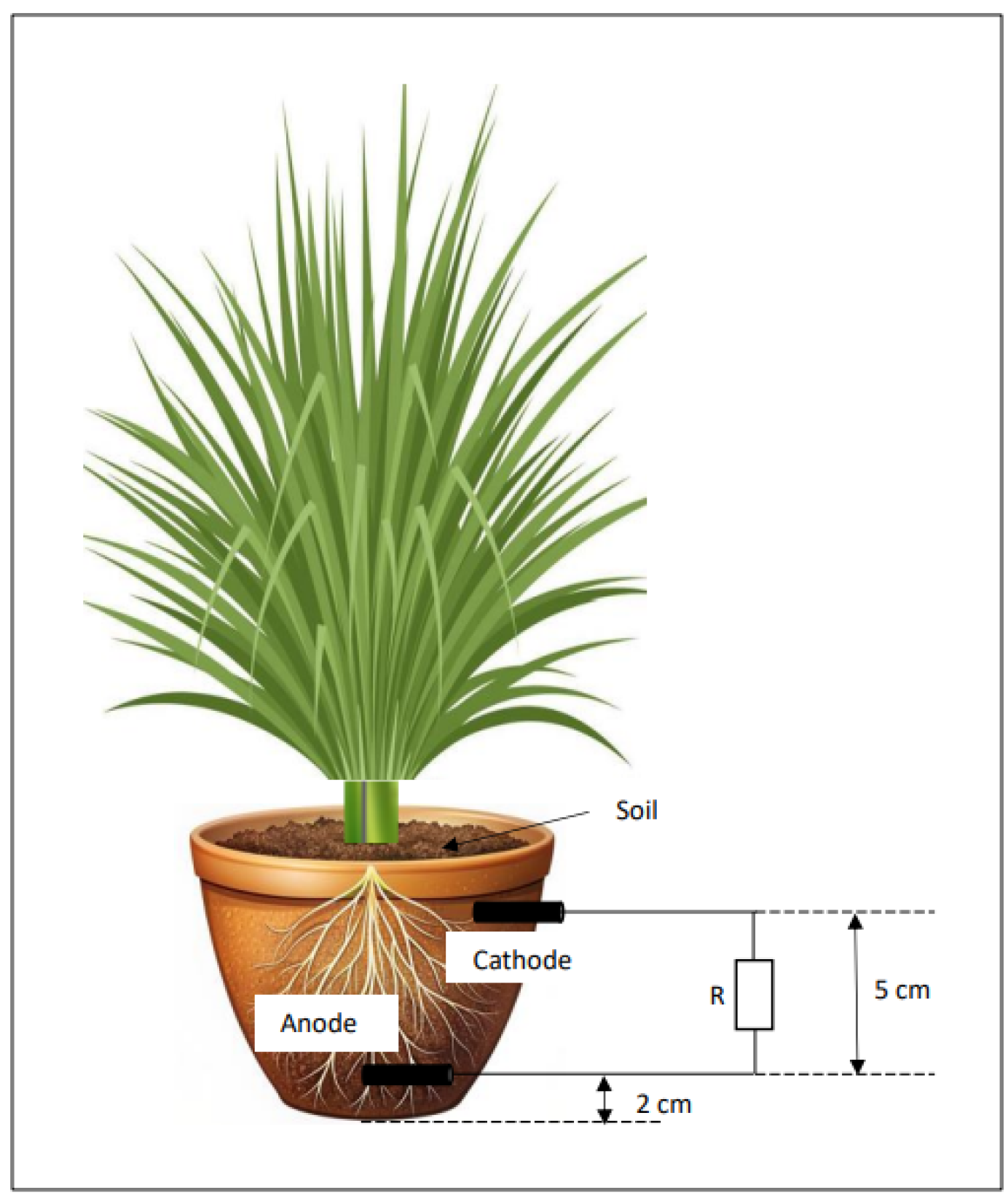

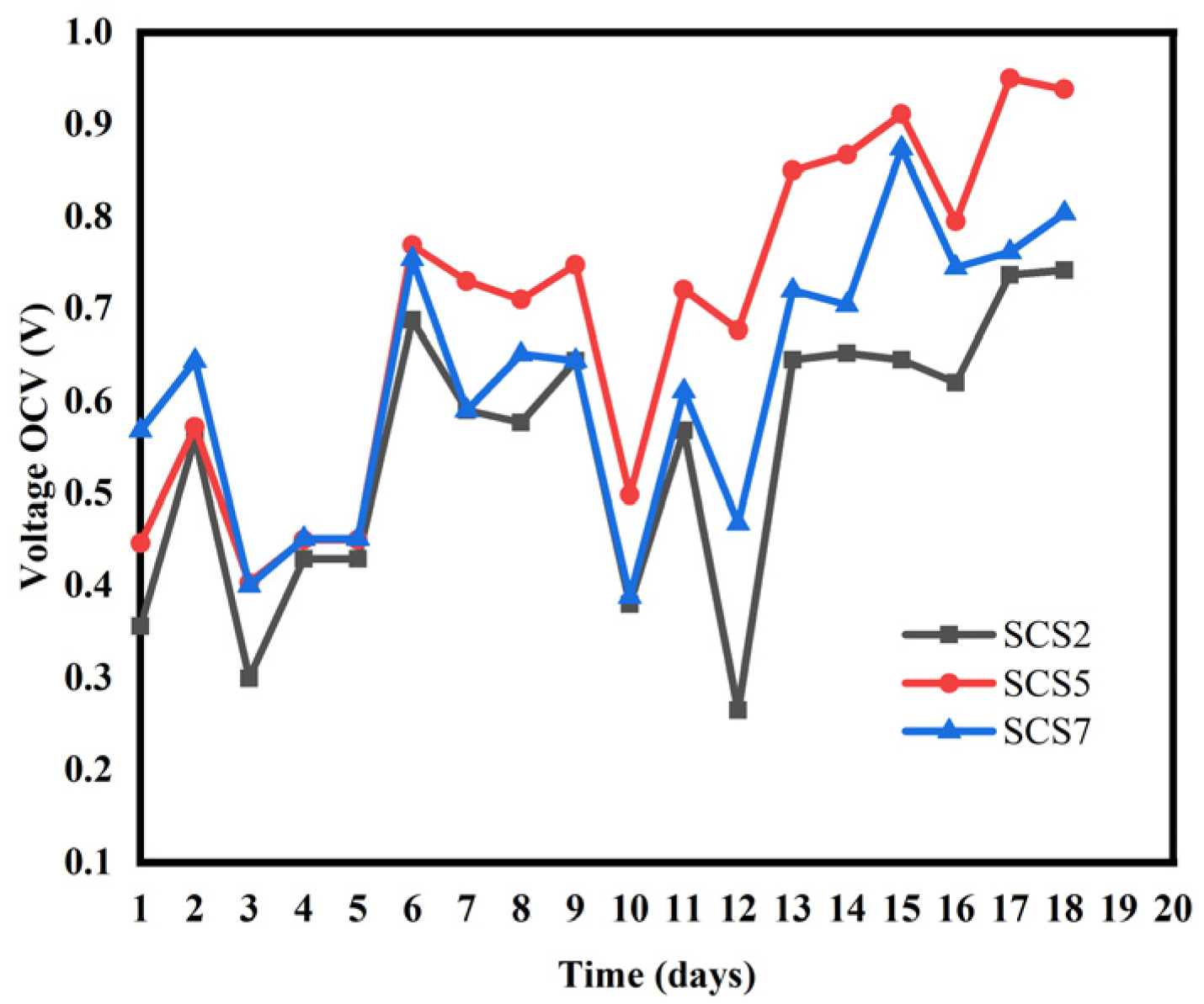
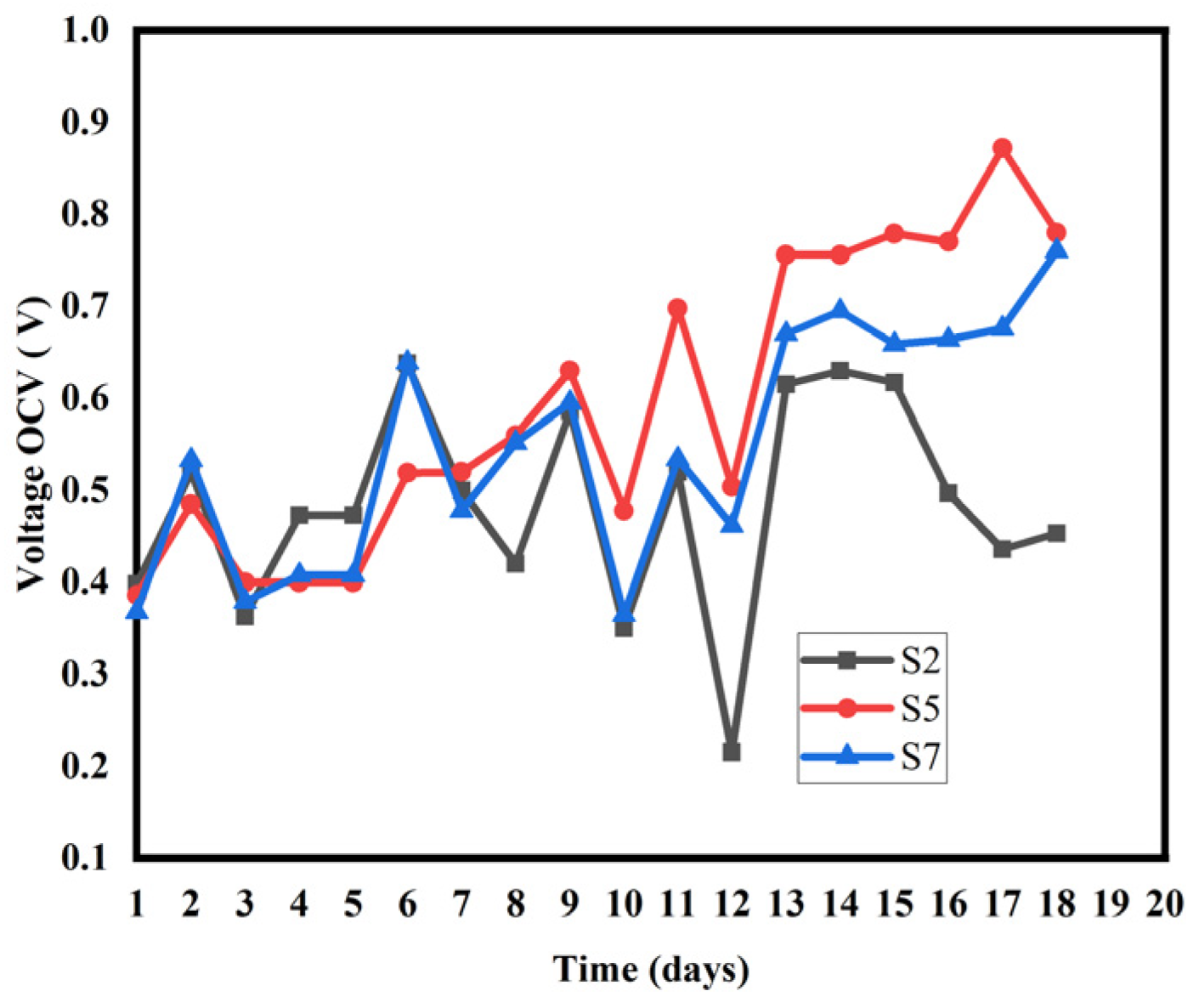

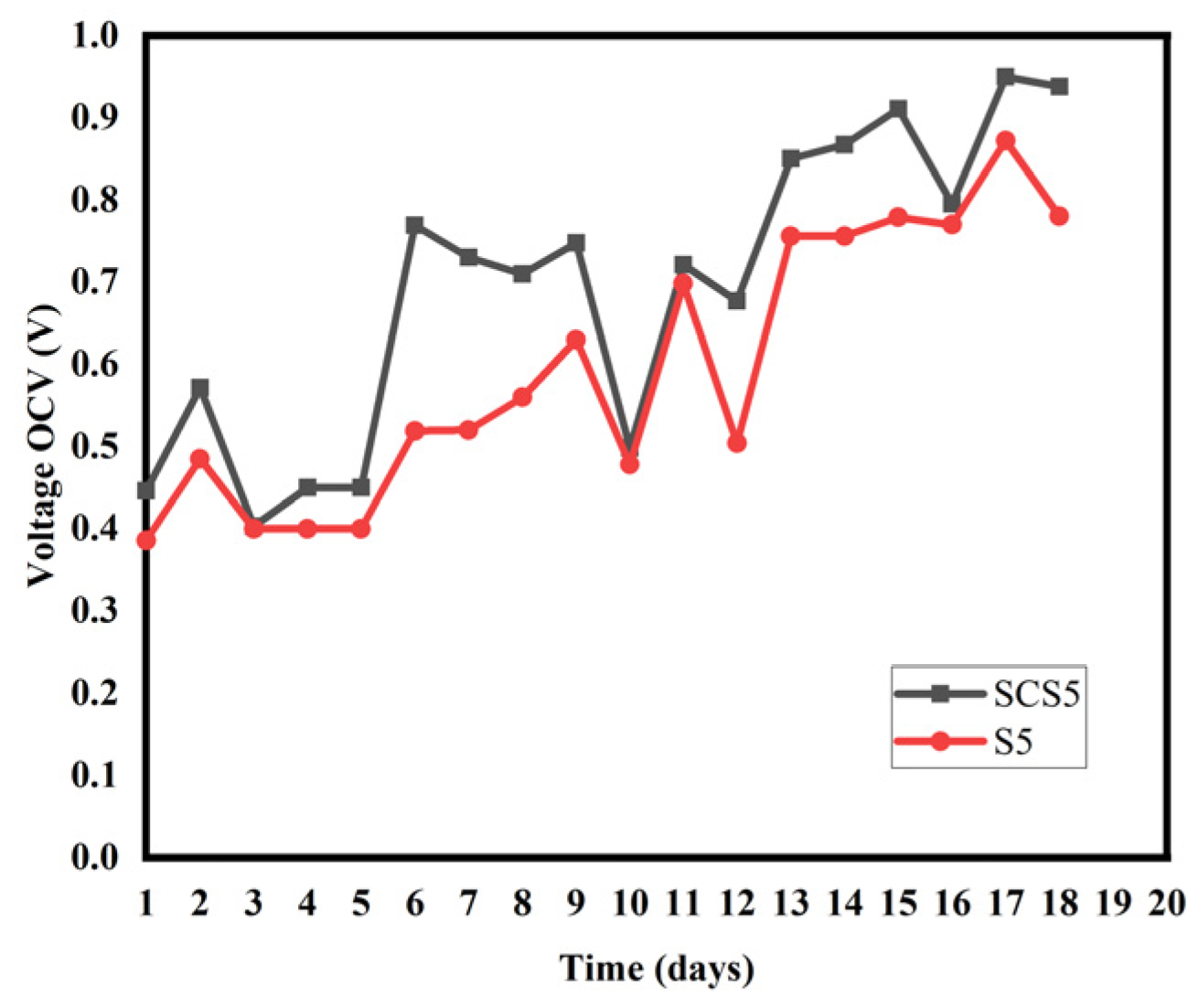
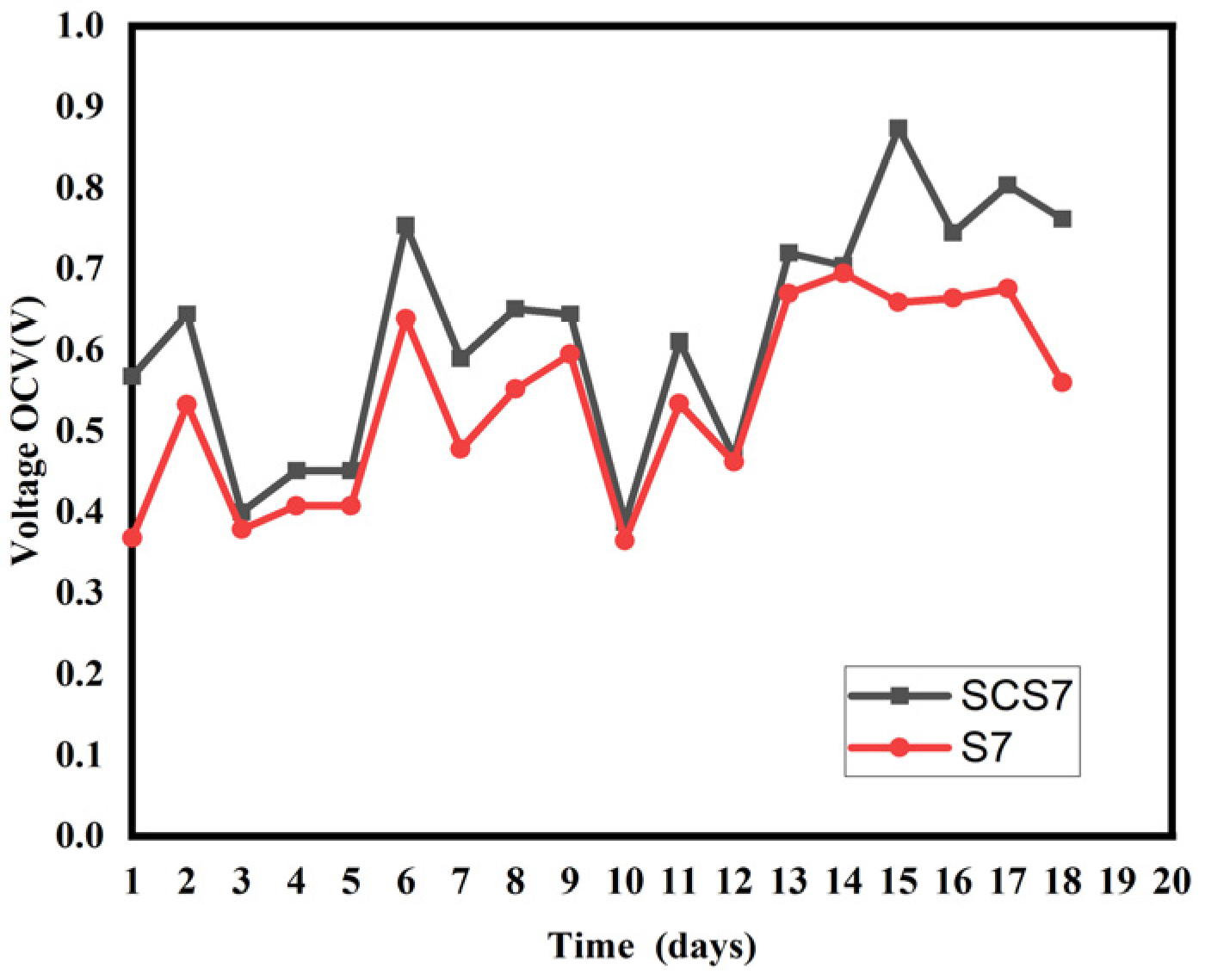
| Pots | ||||||
|---|---|---|---|---|---|---|
| S2 | S5 | S7 | SCS2 | SCS5 | SCS7 | |
| Soil (g) | 2037 | 2037 | 2037 | 1932 | 1932 | 1932 |
| Manure (g) | 63 | 63 | 63 | 63 | 63 | 63 |
| Coconut shell biochar |  |  |  | 105 | 105 | 105 |
| Icc max (mA) | Vocv max (V) | I1000 max (mA) | V1000 max (V) | |||||||||
|---|---|---|---|---|---|---|---|---|---|---|---|---|
| Pots | 6 a.m. | 1 p.m. | 8 p.m. | 6 a.m. | 1 p.m. | 8 p.m. | 6 a.m. | 1 p.m. | 8 p.m. | 6 a.m. | 1 p.m. | 8 p.m. |
| SCS2 | 264.24 | 412.88 | 388.10 | 0.610 | 0.742 | 0.569 | 140.37 | 165.15 | 165.15 | 0.200 | 0.224 | 0.184 |
| S2 | 346.82 | 388.10 | 363.33 | 0.510 | 0.638 | 0.502 | 140.37 | 132.12 | 123.86 | 0.188 | 0.170 | 0.186 |
| SCS5 | 355.07 | 396.36 | 355.07 | 0.911 | 0.968 | 0.761 | 181.66 | 280.76 | 165.15 | 0.260 | 0.270 | 0.220 |
| S5 | 231.21 | 338.56 | 371.59 | 0.738 | 0.872 | 0.850 | 140.37 | 198.18 | 115.60 | 0.236 | 0.240 | 0.230 |
| SCS7 | 189.92 | 330.30 | 289.01 | 0.835 | 0.874 | 0.712 | 156.89 | 198.18 | 148.48 | 0.180 | 0.248 | 0.170 |
| S7 | 173.41 | 297.27 | 231.21 | 0.720 | 0.760 | 0.637 | 107.34 | 181.66 | 123.86 | 0.160 | 0.207 | 0.152 |
| Sample Name | p (%) | d (cm) | OCV (mV) | Pmax (mW/m2) |
|---|---|---|---|---|
| SCS2 | 5 | 2 | 742 | 36.9 ± 0.09 |
| S2 | 0 | 2 | 638 | 22.4 ± 0.06 |
| SCS5 | 5 | 5 | 968 | 75.8 ± 0.05 |
| S5 | 0 | 5 | 872 | 47.5 ± 0.06 |
| SCS7 | 5 | 7 | 874 | 44.4 ± 0.04 |
| S7 | 0 | 7 | 760 | 37.6 ± 0.03 |
Disclaimer/Publisher’s Note: The statements, opinions and data contained in all publications are solely those of the individual author(s) and contributor(s) and not of MDPI and/or the editor(s). MDPI and/or the editor(s) disclaim responsibility for any injury to people or property resulting from any ideas, methods, instructions or products referred to in the content. |
© 2025 by the authors. Licensee MDPI, Basel, Switzerland. This article is an open access article distributed under the terms and conditions of the Creative Commons Attribution (CC BY) license (https://creativecommons.org/licenses/by/4.0/).
Share and Cite
Zingbe, E.; Kongnine, D.M.; Agbomahena, B.M.; Kpelou, P.; Mouzou, E. Influence of Coconut Husk Biochar and Inter-Electrode Distance on the No-Load Voltage of the Cymbopogan citratus Microbial Plant Fuel Cell in a Pot. Electrochem 2025, 6, 9. https://doi.org/10.3390/electrochem6010009
Zingbe E, Kongnine DM, Agbomahena BM, Kpelou P, Mouzou E. Influence of Coconut Husk Biochar and Inter-Electrode Distance on the No-Load Voltage of the Cymbopogan citratus Microbial Plant Fuel Cell in a Pot. Electrochem. 2025; 6(1):9. https://doi.org/10.3390/electrochem6010009
Chicago/Turabian StyleZingbe, Epiphane, Damgou Mani Kongnine, Bienvenu M. Agbomahena, Pali Kpelou, and Essowè Mouzou. 2025. "Influence of Coconut Husk Biochar and Inter-Electrode Distance on the No-Load Voltage of the Cymbopogan citratus Microbial Plant Fuel Cell in a Pot" Electrochem 6, no. 1: 9. https://doi.org/10.3390/electrochem6010009
APA StyleZingbe, E., Kongnine, D. M., Agbomahena, B. M., Kpelou, P., & Mouzou, E. (2025). Influence of Coconut Husk Biochar and Inter-Electrode Distance on the No-Load Voltage of the Cymbopogan citratus Microbial Plant Fuel Cell in a Pot. Electrochem, 6(1), 9. https://doi.org/10.3390/electrochem6010009






